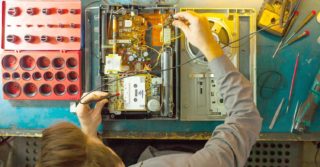 The US Federal Trade Commission (FTC) unanimously voted yesterday to ramp up law enforcement against repair restrictions that can prevent you from fixing your gear.
The US Federal Trade Commission (FTC) unanimously voted yesterday to ramp up law enforcement against repair restrictions that can prevent you from fixing your gear.
They adopted a new policy statement (pdf) aimed at fighting manufacturers’ practices that make it difficult for you to repair your products or to find someone that can repair your products.
Repair restrictions have increasingly become an issue for electronic musicians, especially with the rise of electronic music applications that run on standard mobile devices. Some of the most innovative tools for electronic music in the last decade have been software synths and music applications that run on standard mobile devices.
 For example – in 2005, the JazzMutant Lemur was introduced as a $2,500 state-of-the-art touchscreen music controller. Five years later, though, Apple introduced the iPad, the JazzMutant Lemur was dead, and Lemur was a $50 mobile app.
For example – in 2005, the JazzMutant Lemur was introduced as a $2,500 state-of-the-art touchscreen music controller. Five years later, though, Apple introduced the iPad, the JazzMutant Lemur was dead, and Lemur was a $50 mobile app.
A downside of using mass-produced mobile devices, though, is that they’re extremely challenging to repair, which can leave you with music software or music on a dead, unrepairable device.
And while mobile devices are the most visible example of devices with repair restrictions, the issue is a concern with devices ranging from portable gaming systems to computerized tractors.
In May, the FTC released a report to Congress that concluded that manufacturers are using a variety of methods—such as using adhesives that make parts difficult to replace, limiting the availability of parts and tools, or making diagnostic software unavailable—that have made consumer products harder to fix and maintain.
The new Policy Statement goes further, saying that practices that restrict repairs of your products may be limiting competition for repairs in ways that may violate the law. The Commission says it will target repair restrictions that violate antitrust laws enforced by the FTC or the FTC Act’s prohibitions on unfair or deceptive acts or practices.
“These types of restrictions can significantly raise costs for consumers, stifle innovation, close off business opportunity for independent repair shops, create unnecessary electronic waste, delay timely repairs, and undermine resiliency,” FTC Chair Lina Khan said during an open Commission meeting. “The FTC has a range of tools it can use to root out unlawful repair restrictions, and today’s policy statement would commit us to move forward on this issue with new vigor.”
Image: iFixit

“A downside of using mass-produced mobile devices, though, is that they’re extremely challenging to repair, which can leave you with music software or music on a dead, unrepairable device.”
the upside is they are easy to replace with a new device, and a backup of your data.
this isnt grandpas tube tv; there isnt much to fix anyway, its a single chip, a display and a battery.
You don’t just replace it. You pay double and create more waste which makes no sense.
Now if only they could find ways for planned obsolescence.. ow wait.
People need to understand that Apple creates extreme amounts of waste while marketing itself as the most green company in the world. They spend millions of dollars trying to brainwash the general public. If they really cared about the environment one bit they would pay their taxes so countries could do more about it. Instead they use that money to silence anyone that goes against them.
I think it’s very clear these companies should be forced by law to do better because it’s 100% clear they won’t do it out of themselves.
after 3 or 4 years you want a new device anyway because its a computer and time has moved on …
this has nothing to do with ” planned obsolescence”
You might be taking the phrase too literally. Their plan is to make money for their share holders. What is not their plan? They aren’t planning to give people a device they can use for as long as possible. They aren’t planning to make the world better for their workers or consumers. They will make products people want, I suppose.
As for making money, an obsolete device is the result of the plan, not the goal. If a consumer winds up with an obsolete device, they buy a new one. (It’s that latter part they are focused on). If you have one you can’t repair, it’s just a faster path to the goal.
My laptop is 9 years old, and I’m actually pretty pleased that it generally works well. Just put in a new wifi card & SSD (with nice instructions online) should be good for another 3-4 years. When it stops working, I’ll take it to a center for hard-to-recycle materials and pay to have it properly recycled/disposed of. That’s not available in all areas, and maybe most people won’t take on that level of responsibility.
If your phone/tablet/laptop/desktop is useless after 3/4 years use than you bought a crappy product.
My 17″ MBP did 9 years before I sold it and my new Mac should do the same. If it doesn’t it will be my last computer from Apple.
Fact remains that everything on a Mac is soldered nowadays. That’s clearly done with plannend obsolescence in mind.
My Linux studio workstation i assemblee myself is 13 yrs old and works like a charm
nope, you replace it with a unit that has more beef in the cpu, there is progress every year here …
“Fight the power. Fight the powers that be. Fight the power.” Chuck D
One problem is when you have an app that only runs on older hardware or OS versions. Even “big” companies stop updating apps.
For example, Roli has not fixed a serious bug in their Noise app, which was one of the selling points for their Blocks line of controllers. I have an older iPad that still runs that app fine, but the lightning port has become unreliable, making charging a matter of chance. In theory, I could replace the part but the cost and difficulty are quite high.
That’s an important point. Quite a few years pass between major hardware revisions, i.e., from PPC, to Intel, to the new M1 (“apple silicon”) chip. New (i)OS versions come up fast and furious and developers have to keep up. Older machines won’t run newer OS versions, newer machines won’t run older OS versions, and software developers are in a constant race to deal with whatever hassles the new OS presents.
It would be one thing if the evolution was a constant linear improvement. But with each new release, some important workflow things are broken, made worse, or abandoned. That’s saying nothing of the software we rely on. Yes, some things do get better faster, cleaner, etc. But it is always always a mixed bag, and somewhere in the bag is a stinking steamer.
This will take years to play out, because companies don’t know how aggressive the FTC will be with this.
And the FTC would have to sue for a huge amount of money for it to matter to companies like Google, Microsoft or Apple.
But it does sound like this will at least make it easier to get third-party repairs for mobile devices. This is a big deal, because the manufacturers charge 2-3 times as much for repairs as third party repair companies, and there’s a lot of repairs that you can’t get done by third parties because they can’t get parts.
Repairing something when it’s broken is such a basic thing, kind of bizarre the FTC and governments around the world have to fight for the right to do it. I had to throw out a perfectly fine audio interface once because the manufacturer decided not to release new drivers anymore, while prohibiting users to write their own. Messed up!
Maybe Synthtopia could create a list of companies that do allow repairs and those that don’t allow it?
Probably a huge task to make but would be a nice piece of journalism and a great way to educate people.
I personally would love a raking list of companies that do their best and those that screw us.
In the end these giants got nothing to rule if we keep our wallets closed for them but we need to be aware in order to make that happen.
Hint: the smaller the company in terms of number of employees/turnover/production line, the higher the chance of repairability (there are certainly some exceptions of course, either way).
Sorry to bring the ‘Bodwin’ point to the table, but I wonder how easy it is to repair a certain B- branded synth? Is B- the new Apple of the audio gear industry, flooding the market with cheap and unfixable products that break down after a couple years and are so cheap to begin with that just may as well buy a new one instead of trying to fix it? I’m actually asking the question, not owning any B- synth and not planning to buy any in the foreseeable future. Anyone know about this?
Problem I have encountered with smd parts is with most new synths. A combination of tiny parts and lead free solder. You have to desolder using a rework station, without destroying the surrounding components. So it’s harder for the user to diy a repair. Manufacturers would rather just replace the whole board if a capacitor fails, or if a pot stops working. That requires the manufacturer to have a back stock of replacement boards. So, the question would be whether B and others are prepared to service 5-10 year old products. Imo.
Of course they’re repairable. I have mine open and modified within 30 minutes after they arrive. I’ve swapped 100’s of potentiometers for instance.
B-word might be the Apple of the audio industry in terms of reach and range, but not in terms of quality or support. Apple generally has a very good quality reputation, and I’ve always gotten very good or excellent support from Apple. B-word has, at best, a mixed reputation when it comes to build quality, and the reputation for support is pretty poor. Granted, my impression of their poor reputation is not scientifically derived.
Great news for us here in Australia (hint: headline amusement)
Apple has been one of the worst offenders of this and set the tone for all kinds of horrible practices in this area
and thats just one of their manifold garbage attributes
This will go nowhere fast.
It will increases costs, which will reduce adoption.
Too many people complain these days to little effect. It’s gotten boring.
There are two aspects to the right to repair: 1. How the hardware is designed, and 2. Rules that prohibit 3rd party repair.
WRT hardware, the “Race to Tiny” — making everything as slim as possible– means removing beloved headphone jacks, ever-changing port configurations, glued-in batteries, and microscopic components. People love their devices to be tiny, with less battery life, and less connectivity. And they are not repairable by the user.
WRT to rules/laws to make it harder to repair devices– this is a relatively new thing. We used to be able to find a 3rd party repair shop and get things sorted. Sometimes it was much cheaper than buying a new thingy.
My biggest problem with Apple products is that the user can’t upgrade memory or replace batteries.
Also smaller pocket for device, much bigger pocket for the hub, adapters, and previously-internal-now-external items.
But who can fix or buy my Wavestation EX? Battery dead and a key out but its been sitting there, and now I have a Wavestate. Someone might well be able to use it